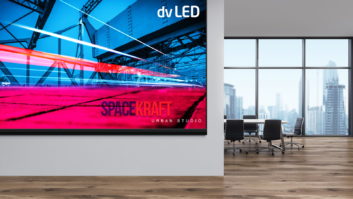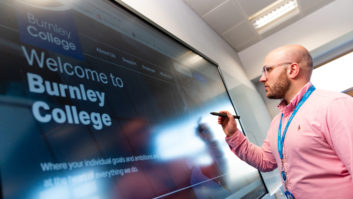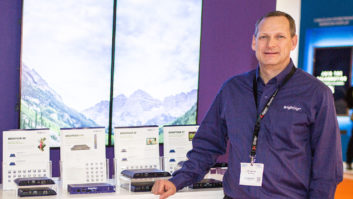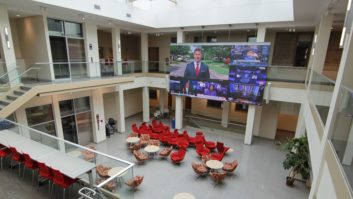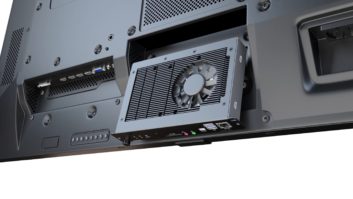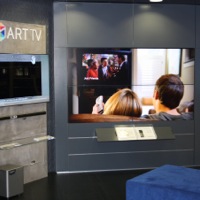
Cost, content and reliability are just some of the factors to consider when installing a digital signage system. Steve Montgomery looks at the many options.
Digital signage covers a wide variety of display applications ranging from single screens in doctors’ waiting rooms to massive nationwide retail advertising systems – each with its own unique set of requirements and constraints.
Suppliers of digital signage equipment have built up a correspondingly wide range of solutions in the hope of providing an exact match to each and every possible installation. System integrators and end users are now faced with a bewildering choice of hardware, software and manufacturer claims about how best to configure, deploy and operate a potential system. This choice is made harder almost daily as new devices, technologies and software solutions become available, including some recent introductions based on players using the Android operating system.
The key criteria for a user when choosing a digital signage system are cost – or more specifically total cost of ownership; functionality, which includes ease of use and capability to display desired types of content; and reliability – longevity of operation and ability to operate with no maintenance.
The priority assigned to each of these factors will vary depending on the type of installation: a single screen in the reception area of a corporate HQ will be run and managed in a completely different way from a national retail advertising network.
Strong base
The most common base platforms for signage systems comprise Windows or Linux operating systems running on PC-based or dedicated media player hardware. In any system it is essential that the underlying hardware and software is tuned and configured for the application and can support the chosen digital signage application software.
Several suppliers opt for the PC route; either on their own-designed hardware solutions or those provided by generic manufacturers.
“Off-the-shelf devices are often used. Many customers want to install signage software on their own PCs and some manufacturers don’t even offer the option of having a manufacturer-supplied player. However these are office machines that are not robust enough for continuous operation, which is why we offer dedicated built-for-task players,” says David Oades, MD of Sedao.
“Windows combined with selected, commonly available PC hardware components offer flexibility, rapid integration and economy – provided it’s all configured correctly. It’s not just the operating system that has to be configured: the BIOS [basic input/output system] needs to have the right functions and the signage software itself must have levels of built-in recovery and restart. On-screen error messages that need user intervention are not acceptable but are all too often observed when incorrectly configured systems are used. For reliability, industrial-grade hardware must be selected and thoroughly tested to create a dedicated player, even though remote player monitoring is a common feature of today’s systems. It’s a complex task to configure the hardware and software to run 24/7, which is why dedicated players carry a price premium. Maintenance and long-term availability are also issues as PC hardware rapidly evolves, generating additional costs that are generally borne by the manufacturer.”
A further advantage of Windows is its familiarity to users. Andrew Emmett, product manager for digital signage at Anders+Kern, says: “We find that large, corporate companies prefer Windows for security reasons and the level of support they can provide to access and update players with new content. Integration behind firewalls is simpler; companies also have the tools and understanding to implement digital signage equipment on their networks. This insight gives them confidence that their system is protected and will not pose security threats from outsiders.”
The widely used alternative is dedicated hardware players specific to digital signage software, usually provided by the digital signage solution provider themselves. These offer tailored and highly efficient playback of high-resolution video files without the unnecessary and power-hungry components of PC architecture players. “The advantage of dedicated players is that they are built to run specific applications, rather than being general-purpose players with the overhead of additional components and unneeded functionality,” explains Jeff Hastings, CEO of BrightSign.
“They can be highly secure, since the operating system is based on Linux and can be locked down more effectively than Windows. They use dedicated hardware GPUs rather than software to decode video more efficiently and at better visual quality, at the same time consuming far less power. Their cost is based on functionality, rather than the base platform and expensive operating systems, so are suited to low-cost simple applications, particularly retail advertising in which rotating video files are infrequently updated and often undertaken manually by shop staff swapping an SD card or USB stick in the unit itself. The downside is that they don’t have the configuration options and flexibility of PC-based solutions or the ability to play complex mixtures of different types of material and content simultaneously.”
Dedicated players can be built to be extremely reliable and robust, both in their construction and operational performance. “Players operate within a few seconds of switching on, and include hardware and software watchdogs that monitor operation and will force a system reboot if necessary,” adds Hastings. “Some of our players have been running for seven years in a theme park in Orlando without problem and with no reported downtime. Even if any of these devices have been rebooted, it is unlikely it will be noticed as it only takes 20 seconds.”
Focused features
Players of this type generally include features that tailor their operation to the application. “AMX signage products incorporate a host of features designed to simplify installation by helping integrators to get started quickly,” explains Jonathan Mangnall, sales director, AMX. “Features include player auto-discovery, easy software installation and flexible design elements. In addition, they integrate with other business productivity tools and monitoring systems, including AMX Control and Resource Management Suite. They use solid-state storage and the latest hardware architectures to provide technology that exceeds the standard of the marketplace.”
The cost of a digital signage system will often play a major part in the selection process; more so in larger, distributed network-based installations where unattended operation is a requirement. It is essential in these cases to consider total cost of ownership (TCO). Elements outside the core equipment cost play a large factor and can often exceed the initial cost of the player and signage software. Again these are affected by the type of hardware used.
Hastings adds: “Windows/PC systems will very likely require pre-installation configuration, either at source or in the supplier’s workshop prior to despatch to site. They may need configuring to attach them to the in-house network and physically connect them to devices in the actual location in which they will operate. All this requires higher levels of expertise than is normally provided for in basic retail and office AV installations, and incurs additional costs and greater burden on the system integrator. Conversely, dedicated equipment designed for these applications is simpler to install and configure; it often performs auto-connection to servers over networks without human intervention.”
Ongoing maintenance is a crucial factor. Two or three site visits to replace defective equipment can easily exceed its original capital cost, even without factoring in loss of confidence and inconvenience to the end user. Repeated system adjustment also eats into profit margins if not highly automated. Any choice of system for a large-scale rollout must consider this, along with installation considerations that do not place undue stress on equipment through poor vibration, location or heat management.
A cost element that is often not considered at the early stage of system design is that of power consumption. “SpinetiX players do not contain any unnecessary components so consume the minimum possible amount of power; about 3W, compared with around 90W for a PC,” explains Serge Konter, marketing manager, SpinetiX.
“This has two advantages. Firstly, reliability is maximised, in fact we offer a product lifetime guarantee for our players: if one fails, return it for a free replacement. Secondly, the lower running cost quickly offsets the slightly higher price of the original player and fully pays back the capital cost of the player in two years.”
Application software, content creation, distribution and player management are another story that is equally, if not more, complex than hardware selection. “There are as many models as there are uses for digital signage,” comments Oades. “Outright purchase is widely preferred on cost grounds; however there are software-as-a-service [SaaS] models which allow customers to rent the software, giving cash-flow benefits in the short term but costing more in the longer term. Sedao offers different models to meet the needs of different markets: one-off outright purchase, unlimited site licences and annual rental. There is no right solution other than it needs to offer value for money.”
software options
Damon Crowhurst, sales director at Scala, concurs with this observation: “Application software options are SaaS and on-premise. Mature solutions tend to offer both, and users should be cautious if it is only available as a supplier-hosted solution, which in young industries tends to hide a lot of negative surprises.
“SaaS really helps get a client started easily, as a Cloud account can be set up within hours and users don’t have to worry about the hassle of back-end databases, back-ups, updates and scalability. On-premise is often easier where data security and confidential information are a concern. That said, there is definitely a shift in the acceptance of Cloud solutions for digital signage within corporate communications, which was not the case two years ago. The retail industry has embraced the Cloud far more quickly. Financially, comparing the two models, the break-even time frame is around 20 months; thereafter SaaS tends to cost more, but without the hassle and internal costs.”
The Cloud is rapidly becoming a highly effective means of distributing content to large, geographically remote systems. Cloud storage and distribution of content provides a cheaper, more flexible and higher bandwidth version of FTP servers and other technology that have been in use in signage systems for many years. The way systems operate is the same but cost savings and speed of delivery make large-scale deployment simpler. The nature of store-and-play content used throughout digital signage (as opposed to streamed display in IPTV systems) is ideally suited to Cloud distribution and it is now possible to make it extremely cheap to distribute content over a wide area to any number of players.
In addition, as Frederik Vroman, business development manager at dZine, points out: “The Cloud provides automatic facilities to convert content to suitable formats for multiple devices, providing the ability to mix players across a network.”
A further, often ill-considered cost of digital signage is that associated with integration of third-party content. It is, as Vroman points out, “the ease of integrating the technology with third-party systems like the box office in a cinema, timetables for public transport and meeting room schedules. We incorporate this in the dZine through content templates capable of using ODBC, XML and other languages. There is also an extensive API available for very specific scripting for integration with services like fire evacuation and security systems.”
It is the system integrator’s job to scope, define and advise end users in the best and most economic solutions open to them. There are many factors to consider and as digital signage systems become more complex and sophisticated, their use and application is growing and this will become even more of a complicated and involved task. n
www.amx.com
www.anders-kern.co.uk
www.brightsign.biz
www.dzine.be
www.scala.com
www.sedao.com
www.spinetix.com
